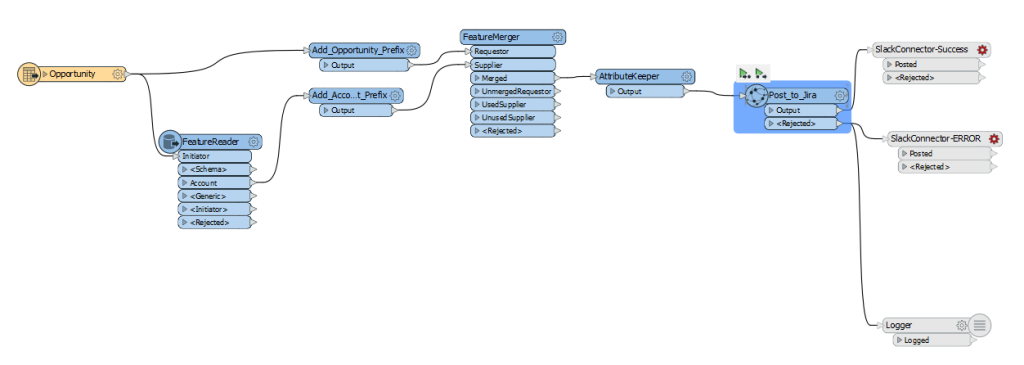In today’s data-driven world, integrating various systems and managing data effectively is crucial for organizations to make informed decisions and remain responsive. Two popular approaches to data integration are using an Integration Platform as a Service (iPaaS) or building a custom data pipeline. Each approach has its advantages and challenges, and the best choice depends on your organization’s specific needs, resources, and strategic goals.
Understanding iPaaS
An iPaaS is a hosted platform that provides a suite of tools to connect various applications, data sources, and systems, both within the cloud and on-premises. It enables businesses to manage and automate data flows without the need for extensive coding, offering pre-built connectors, data transformation capabilities, and support for real-time integration.
For example, the image below shows an integration done in FME, an iPaaS that is commonly used in geospatial environments but has native support for common non-spatial platforms such as Salesforce. This integration creates a Jira ticket each time a new Salesforce opportunity object is created. It also posts notifications to Slack to ensure the new tickets are visible to assignees.

iPaas Salesforce-to-Jira pipeline in FME
This integration illustrates the typical visual nature of the iPaaS design approach, where flows and customizations are designed primarily through configurations, rather than through the development of custom code. This low-code approach is one of the primary value propositions of iPaaS solutions.
Advantages of iPaaS:
- Speed and Agility: Quick setup and deployment of integrations with minimal coding required.
- Scalability: Easily scales to accommodate growing data volumes and integration needs.
- Reduced Maintenance: The iPaaS provider manages the infrastructure, ensuring high availability and security.
Challenges of iPaaS:
- Limited Customization: While iPaaS solutions are flexible, there may be limitations to how much the integrations can be customized to meet unique business requirements.
- Subscription Costs: Ongoing subscription fees can add up, especially as your integration needs grow.
Building a Custom Data Pipeline
Creating a custom data pipeline involves developing a bespoke solution tailored to your specific data integration and management needs. This approach allows for complete control over the data flow, including how data is collected, processed, transformed, and stored. This will typically be done using a mix of tools such as Python, serverless functions, and/or SQL.
Advantages of Custom Data Pipelines:
- Complete Customization: Tailor every aspect of your data pipeline to fit your business’s unique needs.
- Integration Depth: Address complex or unique integration scenarios that off-the-shelf solutions cannot.
- Ownership and Control: Full ownership of your integration solution, allowing for adjustments and optimizations as needed.
Challenges of Custom Data Pipelines:
- Higher Costs and Resources: Significant upfront investment in development, plus ongoing costs for maintenance, updates, and scaling. Proper cost modeling over a reasonable payback period can give a more accurate picture of costs. Many costs will be fixed and may dilute as your organization scales when compared to iPaaS consumption pricing.
- Longer Time to Market: Development and testing of a custom solution can be time-consuming.
- Expertise Required: Need for skilled developers with knowledge in integration patterns and technologies.
Making the Choice
When deciding between an iPaaS and building a custom data pipeline, consider the following factors:
- Complexity of Integration Needs: For complex, highly specialized integration requirements, a custom pipeline might be necessary. For more standardized integrations, an iPaaS could suffice. For example, an ELT pipeline may lend itself more to an iPaaS since transformations will be performed after your data reaches its desitnation.
- Resource Availability: Do you have the in-house expertise and resources to build and maintain a custom pipeline, or would leveraging an iPaaS allow your team to focus on core business activities? Opportunity cost related to custom development should be considered over the development period.
- Cost Considerations: Evaluate the total cost of ownership (TCO) for both options, including upfront development costs for a custom solution versus ongoing subscription fees for an iPaaS. iPaaS tytpically has lower upfront onboarding costs than custom development, but long-term costs can rise as your organization scales.
- Scalability and Flexibility: Consider your future needs and how each option would scale with your business. An iPaaS might offer quicker scaling, while a custom solution provides more control over scaling components.
Conclusion
Ultimately, the decision between an iPaaS and a custom data pipeline is not one-size-fits-all. It requires a strategic evaluation of your current and future integration needs, available resources, and business objectives. By carefully weighing these factors, you can choose the path that best supports your organization’s data integration and management goals, enabling seamless data flow and informed decision-making.
Contact us to learn more about our services and how we can help turn your data integration challenges into opportunities.